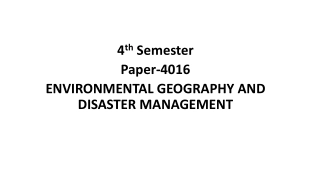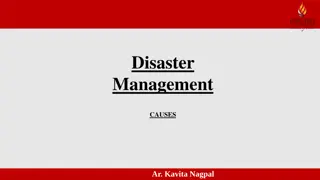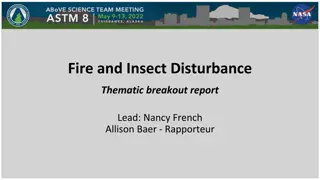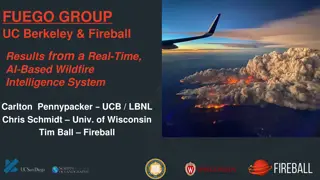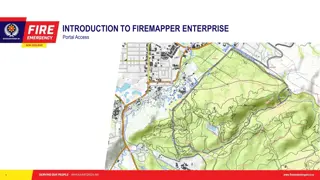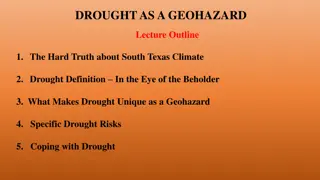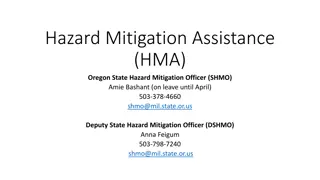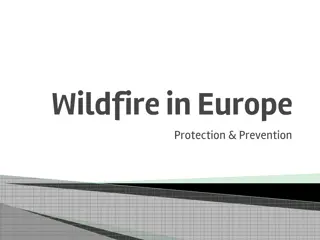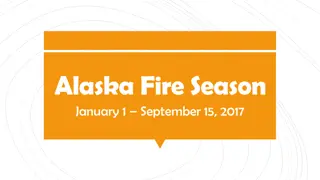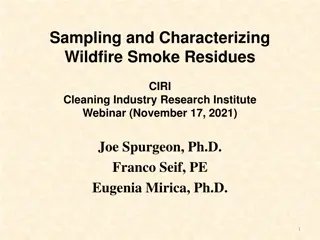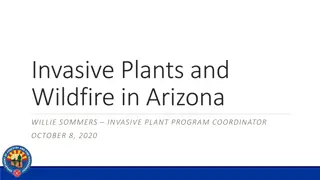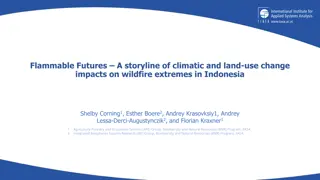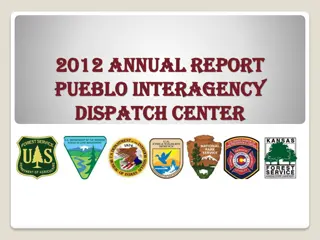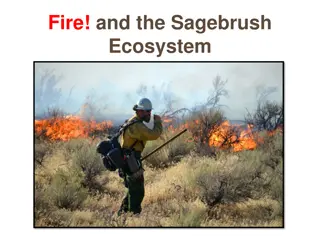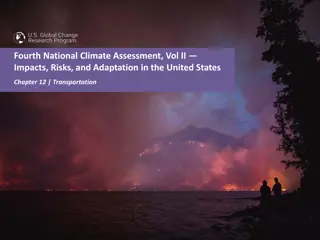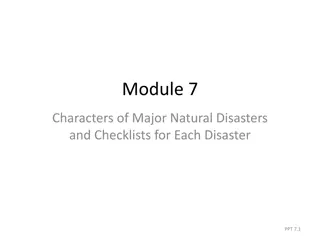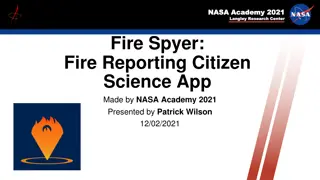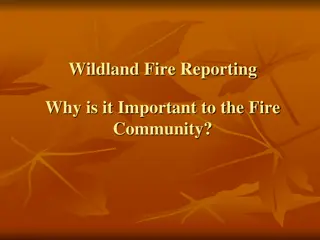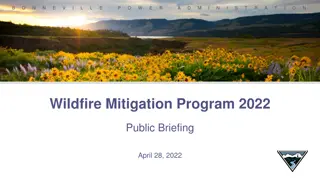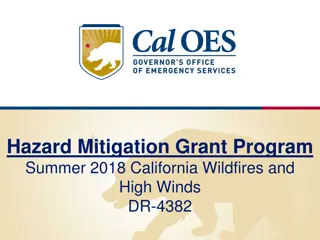Environmental Geography and Disaster Management
The causes, impacts, and management strategies for forest fires/wildfires. Learn about anthropogenic causes, natural causes like lightning, and the threat they pose to biodiversity and ecosystems.
2 views • 13 slides
Understanding Natural Disasters and Their Causes
Explore the various types of natural disasters such as meteorological, geophysical, hydrological, climatological, and biological events, each with unique causes like storms, earthquakes, floods, droughts, wildfires, and more. Learn how these disasters impact the environment and living organisms.
9 views • 16 slides
Boreal Wildfire Effects and Research Synthesis
The thematic breakout report focuses on the impacts of fire and insect disturbances on the environment, with projects studying wildfires in boreal regions and their effects on ecosystems. Various studies funded by agencies like NASA and ERC aim to understand wildfire vulnerability, resiliency, and c
0 views • 10 slides
Fuego: AI-Based Wildfire Intelligence System Detecting Rapid Wildfire Behavior
Fuego, developed by Fuego Group UC Berkeley and Fireball, is a real-time AI-based system focusing on wildfire behavior in the Wildland-Urban Interface (WUI). The system detects wildfires early, surpassing predictions for 2080 severity. It emphasizes the impact on low-income communities, particularly
1 views • 11 slides
FireMapper Enterprise: Enhancing Wildfire Management
FireMapper Enterprise is a comprehensive mapping system designed to assist in managing wildfires effectively. It offers offline functionality, easy fireground feature addition, live map generation, resource tracking, and seamless information sharing between systems. Access is tailored for administra
0 views • 10 slides
Understanding Drought as a Geohazard in South Texas
South Texas faces chronic water scarcity due to its semi-arid climate, leading to frequent droughts. This lecture explores the unique characteristics of drought as a geohazard, its specific risks, and the societal impacts it can cause, including direct meteorological and hydrological effects, as wel
0 views • 13 slides
Hazard Mitigation Assistance (HMA) Funding Eligibility and Priority
Entities within the declared disaster area have priority to apply for Hazard Mitigation Assistance (HMA) funding. Eligible applicants include those in Clackamas, Coos, Douglas, Jackson, Jefferson, Josephine, Klamath, Lake, Lane, Lincoln, Linn, Marion, Tillamook, Wasco, Washington, Yamhill Counties,
0 views • 21 slides
Understanding Wildfires in Europe: Protection and Prevention
Our environment is constantly evolving, and with it comes the pressing need to address environmental challenges like wildfires. In Europe, wildfires pose a significant threat, with a high number of incidents reported annually. This article delves into the impact of wildfires, the extent of forested
1 views • 13 slides
Alaska Wildfires 2017: Overview and Response Efforts
The 2017 Alaska fire season from January 1 to September 15 saw 353 fires covering 652K acres, with 43% caused by natural factors and 57% by human actions. The Alaska Fire Service managed 169 fires in the Upper Yukon Zone, while the state of Alaska dealt with 170 fires and 154 prevention actions. Var
1 views • 13 slides
Advancing Research in Marine Sciences and Atmospheric Environment
CSIRO's Oceans and Atmosphere division is at the forefront of providing valuable insights for managing Australia's marine areas and atmospheric environment. Their research encompasses a wide range of capabilities and programs, focusing on marine protection, resource management, climate prediction, a
0 views • 8 slides
Comparison of Wet-Wipe and Tape Lift Methods for Sampling Wildfire Smoke Residues
This research study compared the performance of wet-wipe and tape lift sampling methods for evaluating the impact of surface char from wildfire smoke residues. The study involved sampling 48 houses in Southern California affected by different wildfires, utilizing side-by-side replicate samples colle
0 views • 56 slides
Managing Invasive Plants and Wildfire in Arizona
The Invasive Plant Grant Program in Arizona is actively combating invasive plant species to prevent wildfires and preserve ecosystems. State funds are allocated for projects targeting species like Saltcedar and Buffelgrass. Grant criteria and projects in 2019 and 2020 reveal a focus on eradicating n
0 views • 19 slides
NIROPS 2021 National Summary and Fire Activity Highlights
The NIROPS 2021 National Summary provides insights into the extensive fire season, covering details such as acres burned, mission dates, request statistics, and busiest night events. The data highlights the challenges faced and the significant efforts of teams in managing wildfires across various re
0 views • 15 slides
Impacts of Climate Change on Wildfire Extremes in Indonesia
A study explores the impacts of climatic and land-use changes on wildfire extremes in Indonesia, focusing on current and future climate-driven fires. The research examines the influence of factors such as drought, economic policies, and adaptation efforts on burned areas, agricultural losses, and la
0 views • 9 slides
National Priorities for Climate Change Science and Knowledge in Canada
Canadians are experiencing firsthand the impacts of climate change, including wildfires, heatwaves, floods, hurricanes, and droughts. To address these challenges, foundational climate change science and knowledge are essential for understanding our changing environment, identifying impacts, making i
0 views • 9 slides
Overview of 2012 Fire Season in Pueblo Zone
The 2012 fire season in Pueblo Zone saw intense fire activity, with notable fires in Kansas and Colorado causing significant damage and casualties. Federal agencies and local dispatch centers worked together to manage the wildfires, evacuating thousands of people and deploying resources effectively.
0 views • 51 slides
Exploring Fire and the Sagebrush Ecosystem
Delve into the dynamics of fire in the sagebrush ecosystem, where fire can spread rapidly, impacting both the landscape and wildlife. Learn about fire management strategies, the role of wildland firefighters, and efforts to create fire-adapted communities. Discover the importance of restoration in m
0 views • 12 slides
Climate Change Impacts on U.S. Transportation Infrastructure
The Fourth National Climate Assessment reveals the risks climate change poses to the U.S. transportation system. Heavy precipitation, coastal flooding, heat, and wildfires threaten the reliability, safety, and efficiency of transportation infrastructure, leading to societal and economic consequences
0 views • 11 slides
Comprehensive Training Module on Natural Disaster Preparedness
In this comprehensive training module, participants will learn about various natural disasters, their causes, and characteristics. They will also be equipped with the necessary knowledge to prepare emergency procedures checklists tailored to different types of disasters. The module covers a range of
0 views • 52 slides
Enhancing Wildfire Response with Fire Spyer: A NASA Academy Innovation
Fire Spyer, developed by NASA Academy 2021 at Langley Research Center, is a cutting-edge citizen science app that revolutionizes fire reporting and monitoring. It addresses issues in current methods by providing real-time data collection, streamlined reporting, and integration with existing systems.
0 views • 7 slides
Importance of Wildland Fire Reporting to the Fire Community
Wildland fire reporting plays a critical role in providing accurate data for effective fire management. Defined state fires and challenges in reporting impact funding, risk management, and agency support. Comprehensive reporting like the Wildland Fire Occurrence Reporting for Massachusetts is essent
0 views • 6 slides
BPA Wildfire Mitigation Program 2022 Public Briefing Overview
The BPA Wildfire Mitigation Program 2022 Public Briefing, held on April 28, 2022, highlighted various aspects including the fire season outlook, wildfire mitigation plan, public safety power shutoff, and strategic management updates. The program aims to address wildfire risks in the BPA service terr
0 views • 18 slides
Australia on Fire: Climate Crisis and Wildfires Threatening the Continent
Australia is experiencing devastating wildfires fueled by factors like lack of rainfall, prolonged drought, and climate change. Record-breaking temperatures and minimal rainfall have exacerbated the situation. The fires, which started earlier than usual, have spread across states like NSW, Queenslan
0 views • 21 slides
Mitigating California Wildfires: Hazard Mitigation Grant Program Overview
The Hazard Mitigation Grant Program (HMGP) aims to reduce loss of life and property from future disasters by implementing long-term risk reduction strategies. The program focuses on creating or updating Local Hazard Mitigation Plans, prioritizing post-wildfire mitigation activities, including soil s
0 views • 18 slides
